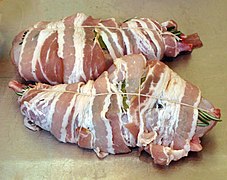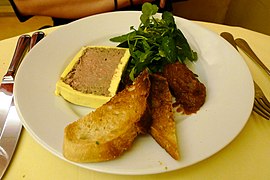Rabbit meat
Rabbit meat (French Lapin de chou , Lapin de clapier or in the case of the wild rabbit Lapin de garenne ) denotes the meat of rabbits and in Europe usually the meat of the domestic rabbit and the wild rabbit ( Oryctolagus cuniculus ). Unlike rabbit meat, meat is usually not assigned to game because the animals usually come from farmed animals .
features
Domestic rabbits are usually kept as pets and are not used for meat production. Breeds that are particularly rich in meat are bred and kept for meat production. Domestic rabbits that are kept for meat production can also be used in some cases to produce rabbit fur . Wild rabbits, on the other hand, belong to the game in Europe and internationally. Compared to the domestic rabbit, the wild rabbit is more compact and usually has shorter and more well-laid ears.
The meat is similar to the hare meat of the field hare , but is usually lighter than this and usually white and sweeter.
Forms of preparation
Young rabbits are usually larded, whole or in parts, and fried, sautéed or made into fricassee . Older animals are braised in pieces or made into farces , soups or pies . In addition to the whole rabbit, different parts of the rabbit are also used separately in the kitchen, such as the rabbit legs , the back of the rabbit or rabbit fillet from the back of the animals.
For the preparation of the rabbit whole or in pieces, there are numerous international preparation forms and several standard recipes.
Rabbit legs covered with bacon, rosemary and bay leaf
Preparations of the animals that have not been cut are comparatively rare, and when they take place the animals are usually prepared stuffed. With the rabbit in the old way ( Lapin à l'ancienne ), the rabbit is fried in butter until stiff, but not browned, and then dusted with flour, poured with white wine and a light stock and steamed in it. Later, pre-cooked onions and mushrooms are added, and the rabbit is coated with egg yolk and sweet cream and served garnished. The English-style rabbit ( lapin à l'anglaise ) is stuffed whole (without head) with a farce of soaked bread, onions and sage , boiled with roots and herbs and served with a caper sauce made from the stock . Coniglio in porchetta , which is widespread in Italian Marche , is also a rabbit meat dish with a filling. Here the rabbit is stuffed with a seasoned filling made from fennel, ham, salami, garlic, rosemary and bread rolls and, after searing in olive oil in fennel stock, braised in the oven. The dish is served with fried fennel vegetables and a sauce made from the stock, wine and cream.
Meals in which the animals are stripped, cut up and prepared in parts are more common than preparations made from the whole rabbit. Often these are fried and then braised with other ingredients to make a ragout. When preparing the rabbit the traditional way ( Lapin à la bourgeoise ), the rabbit is cut into pieces and seared, then dusted with flour, poured with white wine and a brown stock and braised in this. As soon as the meat is half cooked, pre-cooked onions, fried bacon cubes and carrots are added. The burgundy rabbit ( Lapin à la bourguignonne ) corresponds to the bourgeois rabbit, but red wine, mushrooms and onions are added and the dish is topped with croutons . For rabbits with mushrooms ( Lapin aux champignons ), mushroom heads are added to the rabbit pieces braised in white wine and a light demiglace . For the rabbit hunter-style ( Lapin à la chasseur ), the rabbit parts are also seared and dusted with flour and then braised in white wine and brown stock before mushrooms and browned onions are added. The dish is sprinkled with tarragon and chervil to serve. The famous French-style rabbit ragout ( Gibelotte de lapin ) is also cooked from pieces of rabbit, which are then prepared in the same way as hare pepper . When preparing rabbits in beer , the rabbit parts are pickled in a mixture of beer and onions for two days and then, coated with spices and mustard, fried in boiled bacon. Then the meat pieces are cooked with onions, marinade, spices, bacon, thyme and rosemary and finally boiled with beer until the meat pieces can be detached from the bone. The sauce is thickened and rounded off with crème fraiche .
A special preparation is the Belgian sweet and sour rabbit ( Lapin à l'aigre-doux ), in which the rabbit parts are marinated for 24 hours in a mixture of vinegar and white wine and then fried in butter and with demiglace , a brown stock and part of the marinade. The rabbit pieces are placed in a saucepan and topped with vinegar cherries , after which the boiled-down sauce, flavored with chocolate , is poured over the rabbit pieces . The rabbit with plums ( Lapin aux pruneaux ), which is also common in Belgium, is also combined with a sweet note , in which the rabbit parts are also marinated in vinegar and then fried in butter. Then the meat is poured with water and marinade and soaked and pitted prunes are added. The meat is stewed in it, and the sauce is seasoned with currant jelly before serving.
In various dishes, the rabbits are fried in parts, usually marinated or breaded beforehand. In the classic fried rabbit ( lapin frit ), the rabbits are marinated in lemon juice, onions or shallots, olive oil and salt and pepper and then breaded and fried in butter. For the Lombard style rabbit or Coniglio fritto alla lombardo , the rabbit is also cut into pieces, but then seasoned with a mixture of beaten egg, chopped basil and parsley , crushed rosemary and salt and pepper and then breaded with grated white bread. The pieces are then fried in olive oil. When preparing the Coniglio in umido from Liguria , the rabbit pieces are fried in hot olive oil, butter, garlic, rosemary, sage and bay leaves, then seasoned with salt, pepper, nutmeg and wine and then boiled. Then tomatoes are added and cooked together with the meat. To serve, you add pistachios and parsley over the dish. The Coniglio in peperonata comes from the Italian region of Piedmont , in which the rabbit parts are rubbed with salt, pepper and garlic and then fried in boiled bacon and olive oil, then they are braised in meat broth with rosemary. Paprika strips fried in olive oil, garlic and white wine vinegar and mixed with anchovies are added to the meat and stewed with the meat.
In the Provencal style rabbit ( Lapin à la Provençale ), the rabbit parts are fried in olive oil and then steamed in a Provencal sauce . In the case of rabbits of the Hungarian style ( Lapin à la hongroise ), the rabbit parts are heavily paprika and seared after searing in clarified butter and then steamed with a light stock and sour cream. When preparing the Spanish way ( Lapin à l'espagnole ), the rabbit pieces are browned with bacon and onion and then seasoned with salt and paprika. Then peeled tomatoes and peppers cut into strips are added and everything is poured with a little stock and steamed. In the German dish Rabbit Weinbauern-Art, the rabbit parts and rabbit liver are fried golden brown with butter, onions, garlic, rosemary, thyme and sage as well as squashed juniper berries . Then they are extinguished with red wine and braised with tomato paste. The pieces of meat are served with the sauce bound with crème fraiche.
The baked rabbit ( lapin au four ) is cooked in pieces in the oven. To do this, the rabbit pieces are fried and half-smeared with mustard, sprinkled with grated white bread and thyme, and buttered before they are baked in the oven.
Other forms of preparation for rabbits include rabbit patties, in which the meat is severely chopped up and processed with other ingredients into pies or terrine dishes.
supporting documents
- ↑ a b c d e f g h “Rabbit” In: F. Jürgen Herrmann (Ed.): Herings Lexicon of the Kitchen. Fachbuchverlag Pfanneberg, Haan-Gruiten 2012 (licensed edition Nikol, Hamburg 2016); Pp. 380-381. ISBN 978-3-86820-344-8 .
- ^ Franco Benussi, Reinhardt Hess, Sabine Sälzer: The real Italian cuisine, Gräfe & Unzer, Munich 1990 (licensed edition of the German Book Association 09818/6); Pp. 146-147.
- ↑ a b German cuisine. From the Alps to the North Sea. Lichems Verlagsanstalt, Munich 1987 (special edition Engel Verlag); Pp. 94-95.
- ^ Franco Benussi, Reinhardt Hess, Sabine Sälzer: The real Italian cuisine, Gräfe & Unzer, Munich 1990 (licensed edition of the German Book Association 09818/6); P. 35.
- ^ Franco Benussi, Reinhardt Hess, Sabine Sälzer: The real Italian cuisine, Gräfe & Unzer, Munich 1990 (licensed edition of the German Book Association 09818/6); P. 112.
literature
- F. Jürgen Herrmann (Ed.): Herings Lexicon of the kitchen. Fachbuchverlag Pfanneberg, Haan-Gruiten 2012 (licensed edition Nikol, Hamburg 2016); Pp. 380-381. ISBN 978-3-86820-344-8 .





